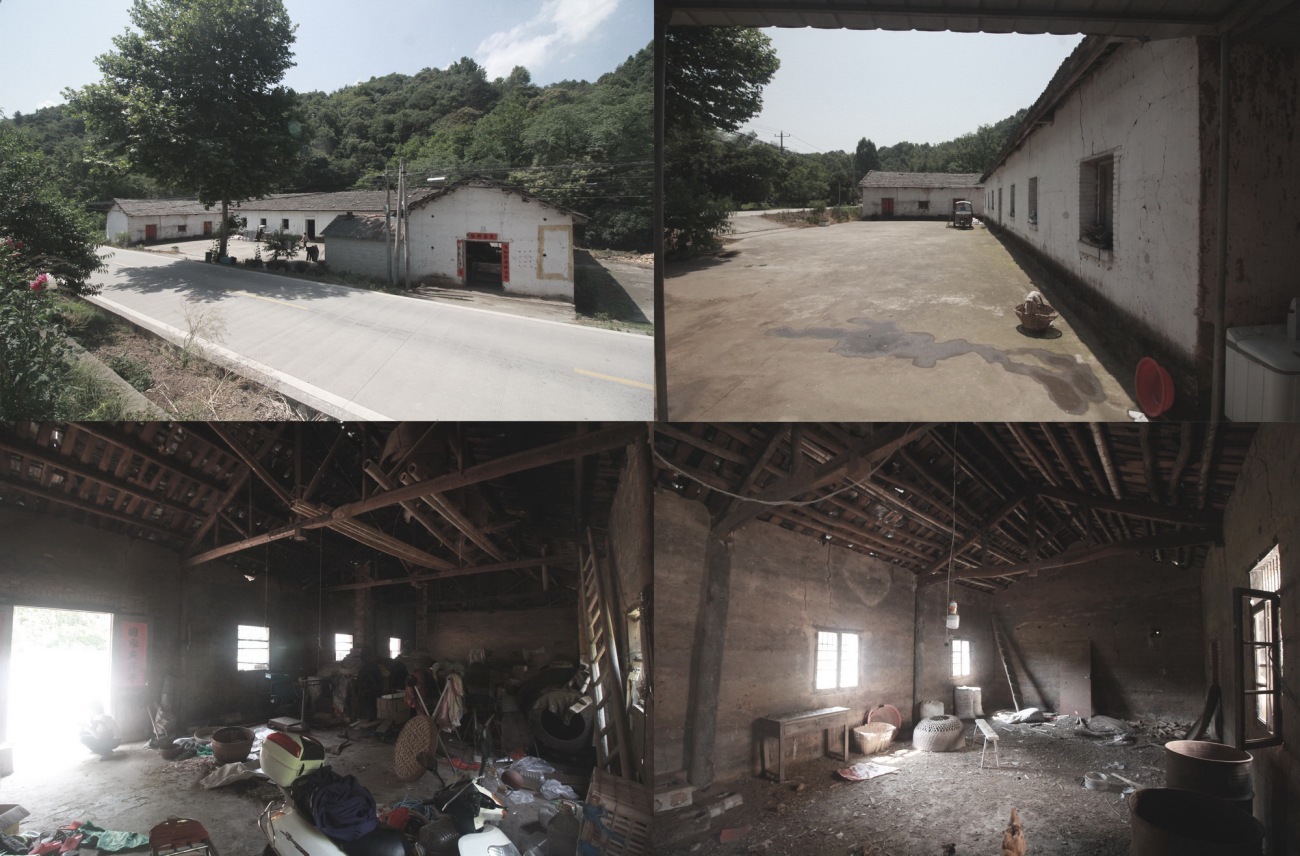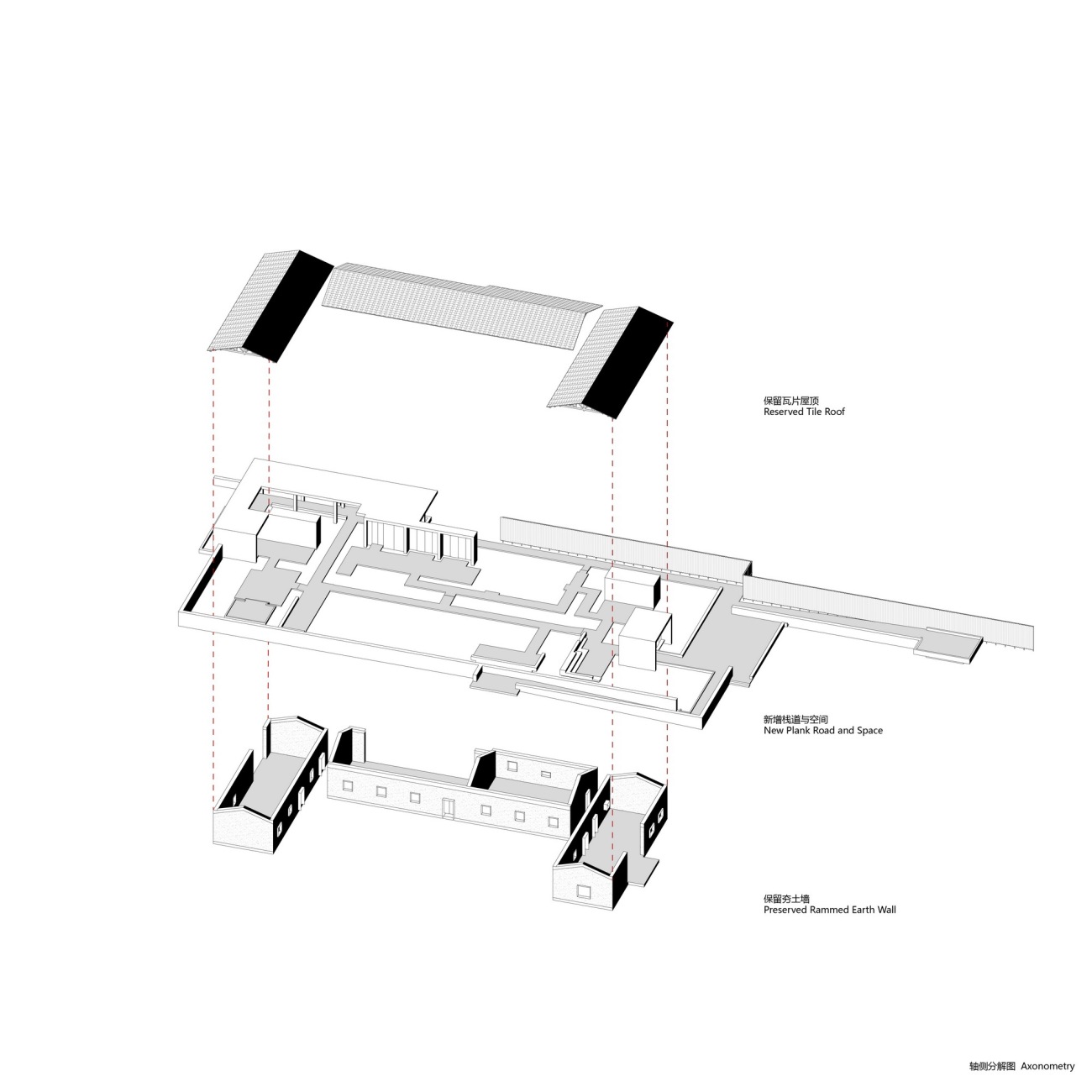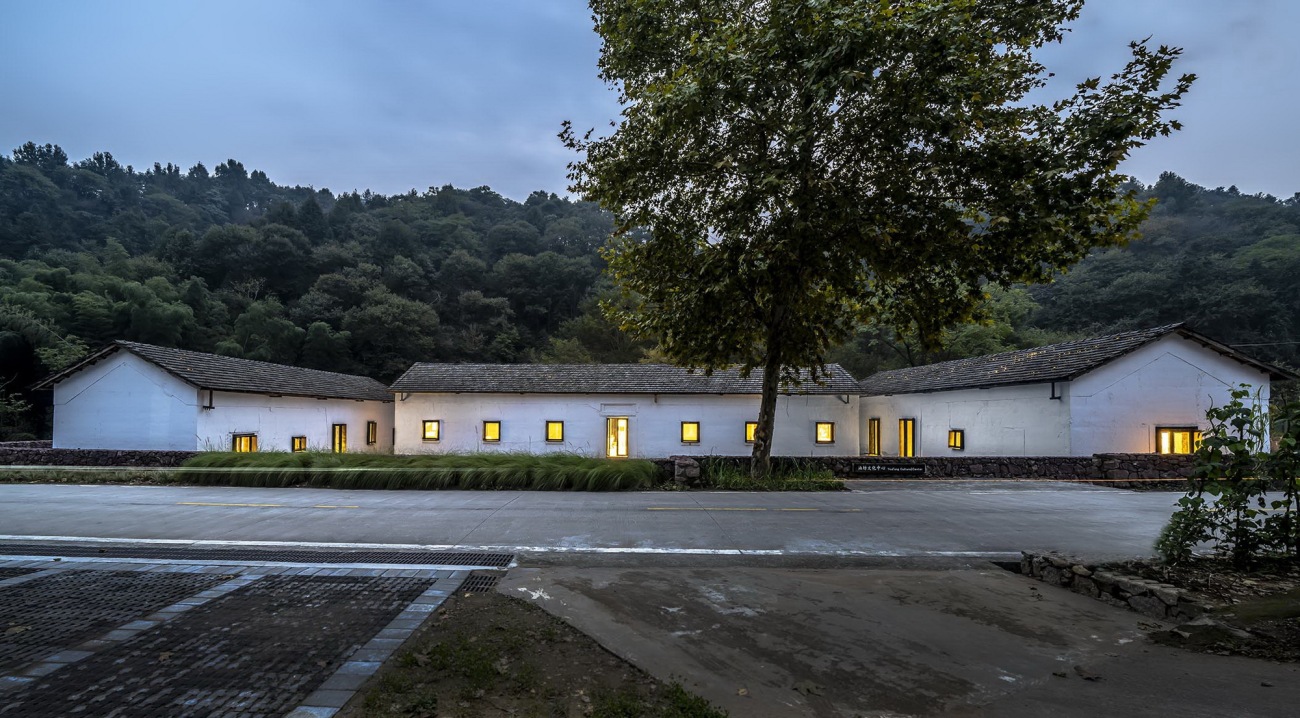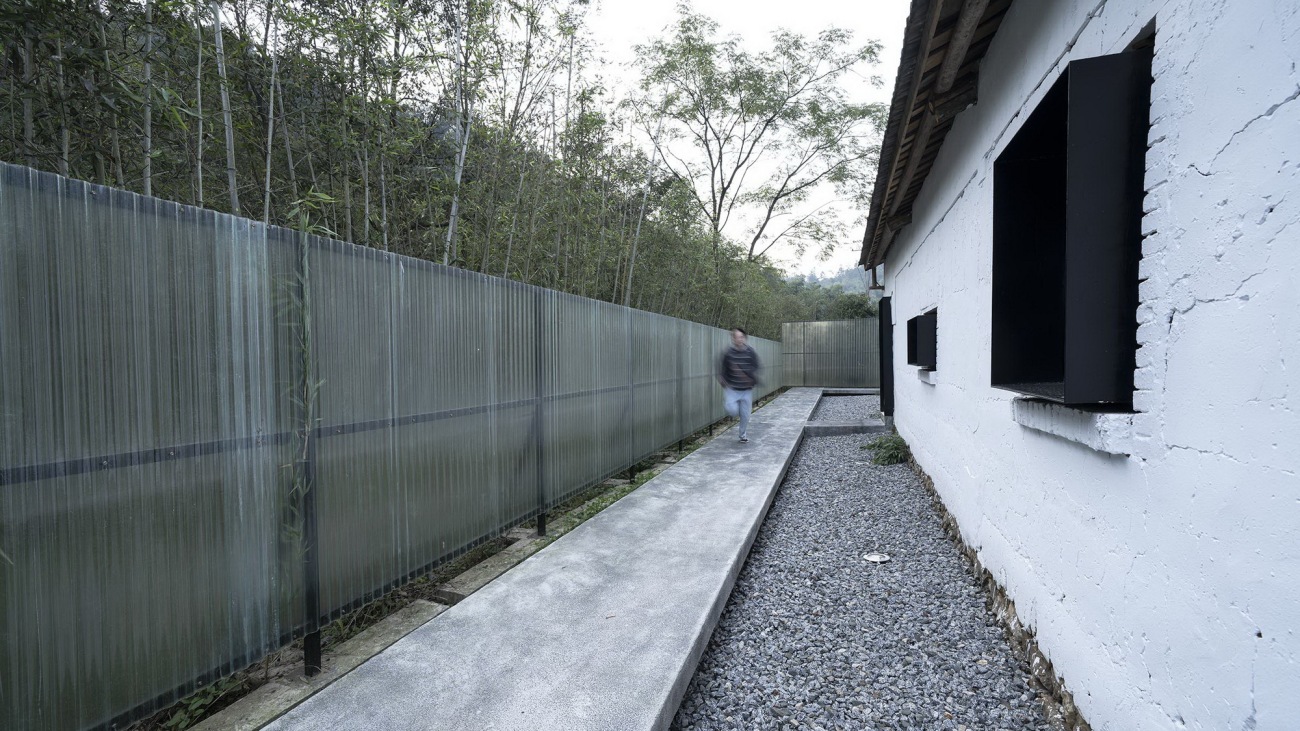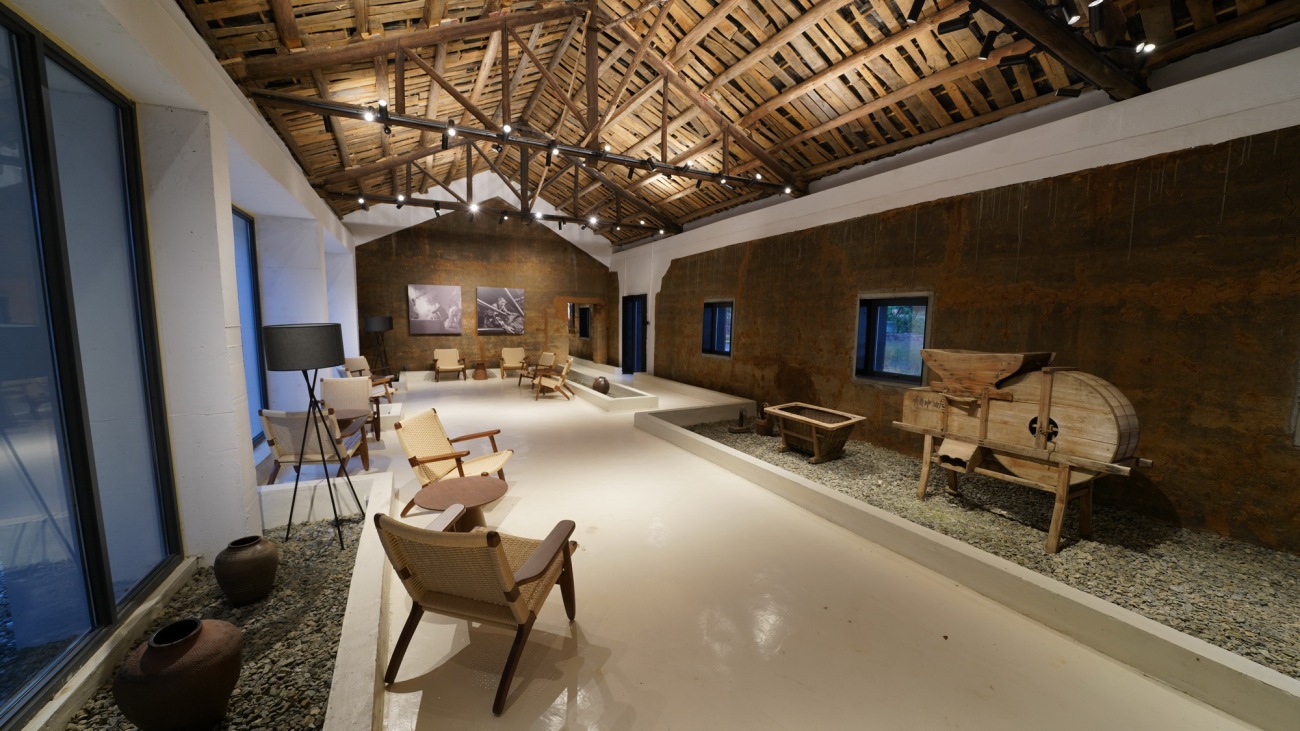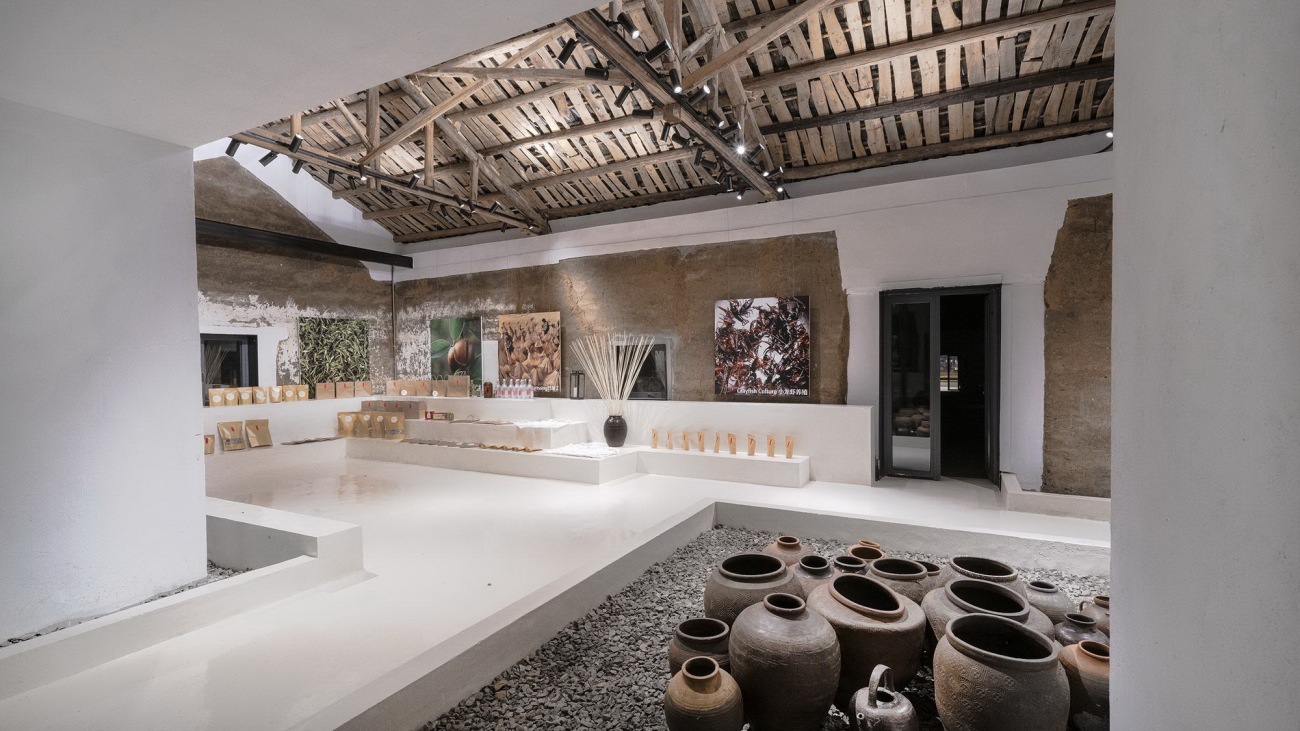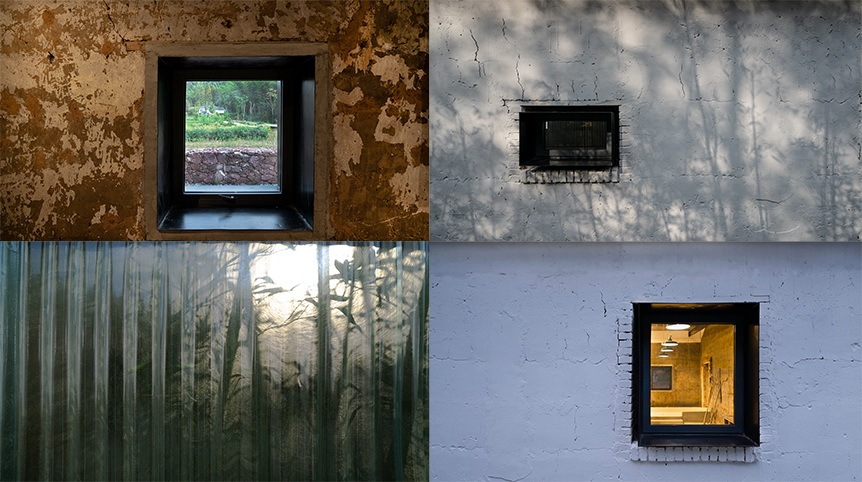牛角冲位于霍山县大别山麓,油茶种植是村里的主要产业之一,除了满山的茶田外,村中还保留着一处始建于上世纪60年代的油坊。但同很多传统手工艺一样,手工作坊生产茶油的方式被工厂机器加工所取代,老油坊也因此被闲置了。位于大别山旅游线路上的牛角冲村决定改造这座昔日老油坊,使其成为乡村文化活动和特产展示售卖中心。
Niujiaochong is located at the foot of the Dabie Mountains in Huoshan County, where tea production is one of the main industries. Besides the tea fields covering the hills, the village still preserves an oil mill built in the 1960s. However, like many traditional crafts, the method of producing tea oil in handcraft workshop has been replaced by factory machines, leaving the old oil mill standing idled. The village of Niujiaochong decided to renovate the oil mill and transform it into a cultural activity center and a showcase for local specialties.
保留昔日的生活记忆
Preserving Memories of the Past
老油坊坐落于村庄主干道旁的茶田中,背靠一座毛竹丛生的山坡,一条小溪从油坊后方流经整个村庄。油坊由三座夯土房组成,面向村内道路围合出一个半开放内院,建筑形式是当地传统建筑常用的夯土墙与抬梁式木屋架。由于长期弃置缺乏维护,土墙已有多处开裂,局部甚至出现倾斜。
The oil mill is located in the tea fields along the village’s main road, back of the mill is a bamboo-covered hillside, with a small stream flowing from behind the mill. The oil mill consists of three traditional-styled rammed-earth houses arranged around a semi-open courtyard facing the village road. Due to long-term abandonment and lack of maintenance, the rammed-earth walls have developed multiple cracks, with some areas even leaning aside.
▽油坊原状 Before the renovation
在时代的变迁中,不仅是手工压榨茶油的工艺,村内的传统夯土民居也重建为现代样式的建筑,老油坊几乎是村里仅剩的一组老建筑。虽然它本身仅是一组乡间普遍存在的夯土建筑,不具有文物层面的保护价值,但它承载了过去一段时期内当地百姓生活劳作的日常,是唤起昔日记忆的存在。因此修复老油坊的重点并非还原建筑原貌,而是在保留人们对油坊记忆的基础上,使其与新功能更好地融合和再生。因此重新梳理空间流线,平衡保留、拆除和新建的关系成为设计的关键。
With the changes brought by time, not only has the craft of hand-pressing tea oil been replaced, but the traditional rammed-earth houses have also been rebuilt into modern-style buildings. The oil mill is almost the only remaining traditional building in the village. Although it is just a common rural structure without significant historical value, it embodies the past time of the local people. Therefore, the renovation should be based on preserving the general image of the oil mill, integrating it with new functions for its regeneration, redesigning the spatial layout, and balancing preservation, demolition, and new construction.
流线与功能
Circulation and Function
老油坊是以院子为中心的内向型生产建筑,周边虽有茶田和竹林的景观,却没有被引入到空间关系中。原有的空间动线依据生产流线组织,从主干道直接进入内院,方便生产材料的运输,以内院为中心串联起三个建筑内不同的生产环节。而改建为文化中心的新油坊在功能上将转变为以农展品展示,手工艺体验,以及宣教讲演为主的文化空间,需要的是具有游览性质的漫步流线,并能和周围的景观形成积极的互动。因此,我们引入了一条连续贯通室内外的步道作为游览路径,步道漂浮于原有地面之上,如同桥一样将油坊的三座建筑孤岛和周边的景观连接起来。
Although the oil mill was surrounded by tea fields and bamboo forests, the landscape was not incorporated into its spatial relationship. The circulation of the oil mill was organized according to the production process and within the courtyard. The renovated oil mill will function as a culture center for showcasing, craft experiences, and educational presentations. It requires a meandering circulation for visitors, with close interaction with not only the interior space but also the surrounding landscape. Therefore, we introduced a continuous walkway as a tour path, floating above the original ground and linking the isolated building to the surrounding scenery.
将面对主干道半开放的院子用一道毛石矮墙围合,转为内向的庭院,作为嘈杂的交通干道和建筑之间的缓冲。主入口也相应转移到侧面。通过景墙引导人们走上步道,穿过茶田漫步到建筑侧面的入口,再相继进入内院和油坊后侧的滨水的廊道,抑或走上延伸进茶田内的观景平台,在步道的引导下,进行一次次室内外的转换以及对不同空间的体验。
The courtyard is enclosed with a low stone wall, transformed into an inward-facing courtyard that serves as a buffer from noisy transportation. Visitors are guided by the scenic wall, walking into the building through the tea fields, entering the inner courtyard and the riverside corridor, or ascending to the viewing platform extending into the tea fields. The walkway allows for continuous transitions between indoor and outdoor spaces and the experience of different spaces.
我们将油坊面对河道和茶田的窗洞口扩大打开,拆除部分原有墙体,将景观引入到建筑内部,加建面向河道的廊道和延伸进茶田的平台,通过改善流线来增强室内外的空间互动。油坊面向内院的立面不做新建,仅拆除后期局部加建的构筑,以达到风貌的还原和统一,将内院作为一个同过去记忆对话的空间。
Part of the windows facing the river and tea fields are enlarged, and some walls are demolished to introduce the landscape into the building. A new corridor facing the river and a tea field platform were added to enrich the outdoor special experience. The façade facing the courtyard remains unchanged, the later additions were removed to rebuild the authentic appearance, making the courtyard a complete space for the past memories.
▽总平面图 Plan
▽轴测图 Axonometric
新与旧的关系
The Relationship Between the Old and the New
步道系统也是新建部分的依托和基座。坐凳、景观窗、廊道、观景平台、室内新增的功能空间等构筑均依托在步道上。步道贯穿在室内外之间,以叠加的方式架高在油坊原有的地面上,边界和墙体脱开,或贴近或退让:时而是一米宽的走道,时而拓宽成活动平台,在平面上形成生动的图底关系。原有的地面覆以碎石,步道和平台如同船只一样漂浮在水面上。新建部分使用了新的材料,室外为水洗石饰面,室内为白色环氧树脂漆,和原有的材料做出区分,增加历史的辨识度和层次感。新建的空间系统如同水流将原有三座独立的建筑串联咬合在一起,形成一个新的具有流动性的整体空间。
The walkway also serves as the foundation for the new construction. Benches, openings, corridors, platforms, and new functional spaces inside the building are all arranged according to the walkway. The walkway traverses between indoors and outdoors, elevated above the original ground of the oil mill, detaching from the walls, various in width, creating a dynamic figure-ground relationship in the floor plan. The original ground is covered with gravel, and the walkway and platforms float above like boats on water. The renovation uses exposed aggregate finishes outdoors and white epoxy resin paint indoors, to distinguish from the original materials, enhancing historical layering and recognition. The new constructions connect and integrate the separate buildings and landscape, forming a complete space full of fluidity.
▽爆炸图 Exploded view
▽改造分析图 Renovation analysis diagram
原有建筑的夯土结构损坏严重,部分墙体开裂变形,如何修复现有夯土墙是改造的难点,在与当地工人修复讨论中我们意外得知,附近的村内仍然存在掌握夯土修复技术的工人,可以矫正现已歪斜开裂的土墙。工人们首先将倾斜墙体支撑扶正,在墙体下部打入木楔固定,然后再将下部缝隙修补。使用传统的工艺,不仅最大化的保留了建筑原来的样貌,也让传统手工艺的延续成为了可能。
Reparation of the rammed-earth walls was a challenge. In discussions with local workers, we unexpectedly learned that there were still craftsmen in the surrounding villages who mastered the skills of rammed-earth restoration. They corrected the tilted and cracked walls by first supporting and straightening the leaning walls, fixing them with wooden wedges at the base, and then repairing the gaps. By using traditional techniques not only maximized the preservation of the building's authentic appearance but also made it possible to continue the traditional craft.
建筑内部展厅收集了村庄中的许多旧农具和油坊的老照片,作为村庄的集体记忆保留正在油坊之中,人们在空间中休憩,参观和活动的时候也是与过去时光的对话。
The exhibition hall inside the oil mill collects various farm tools and photos from the old times, together with the oil mill, representing the village’s memory. As people gather, visit, and participate in activities in the space, they are also engaging in a dialogue with the past.
▽鸟瞰照片 Bird view
▽俯瞰照片 Top view
▽前院 Front yard
▽菜地栈道 Walking path in the vegetable patch
▽前院 Front yard
▽入口 Entrance
▽前院 Front yard
▽后院步道 Backyard walking path
▽后院步道及屏风 walking path and screen panel
▽滨水回廊 Riverside corridor
▽滨水回廊 Riverside corridor
▽茶田栈道及屏风 Screen panel and walking path in the tea field
▽茶室 tea room
▽茶室 tea room
▽油坊体验区 Space for craft experience
▽特产展厅 Specialty exhibition room
▽活动室 Community room
▽细节 Details
结语
Conclusion
类似宫殿庙宇、宗族祠堂、名人故居这类具有历史性和唯一性的建筑因其文物属性通常会得到很好的保护。而油坊这样大量存在的日常性建筑,随着时代的更迭通常会被拆除。但却是这些建筑承载了过去某个地域、某一时期下,普通百姓们的劳作和生活,这些与我们普通人密切相关的日常同样值得被记住和保留。改造后的文化中心成为牛角冲村内一处具有集体记忆点的公共空间,让老油坊成为一艘承载着人们生活记忆的小船,在时代的长河中继续航行。
Unlike historical buildings that are often well-protected due to their cultural significance, normal buildings like oil mills, are usually demolished as times change. However, these buildings carry the lives of ordinary people in a specific region and period, and this everyday aspect, closely related to ordinary people, also deserves to be remembered and preserved. The oil mill is regenerated as a public space in Niujiaochong village, becoming a small boat carrying past memories sailing in the river of time.
项目信息:
项目地点:安徽省霍山县牛角冲村
设计时间:2021.8
建成时间:2022.7
面积:1580平米
主创建筑师:傅英斌
团队:赵思媛、宋嘉、官苗苗
撰文:赵思媛
翻译:赵思媛
邮箱:fuyingbin999@126.com
摄影版权:傅英斌工作室
Main Information
Project Location: Niujiaochong Village, Huoshan County, Anhui Province, China
Design Year: August, 2021
Completion Year: July 2022
Site Area: 1580sqm
Chief Designer: FU Yingbin
Design Team: ZHAO Siyua, SONG Jia, GUAN Miaomiao
Article and translation: ZHAO Siyuan
Contact: fuyingbin999@126.com
Photographic Copyright: FU Yingbin Studio
更新日期:2024-08-27 16:45:56
非常感谢 傅英斌工作室 带来的精彩项目, 查阅更多Appreciations towards Fu Yingbin Studio for sharing wonderful work on hhlloo. Click to see more works!
